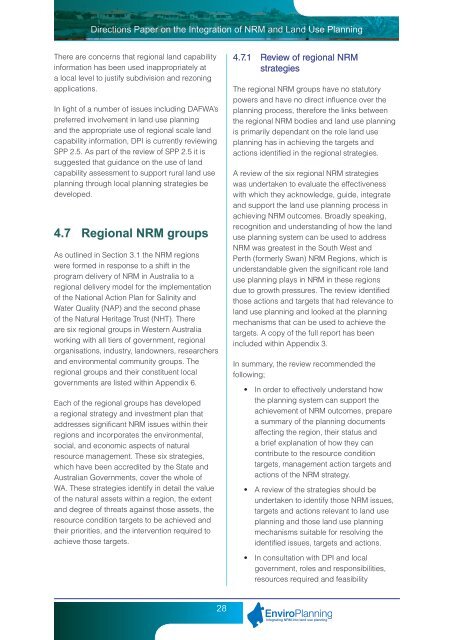Directions Paper - Western Australian Planning Commission
Directions Paper - Western Australian Planning Commission
Directions Paper - Western Australian Planning Commission
Create successful ePaper yourself
Turn your PDF publications into a flip-book with our unique Google optimized e-Paper software.
<strong>Directions</strong> <strong>Paper</strong> on the Integration of NRM and Land Use <strong>Planning</strong>There are concerns that regional land capabilityinformation has been used inappropriately ata local level to justify subdivision and rezoningapplications.In light of a number of issues including DAFWA’spreferred involvement in land use planningand the appropriate use of regional scale landcapability information, DPI is currently reviewingSPP 2.5. As part of the review of SPP 2.5 it issuggested that guidance on the use of landcapability assessment to support rural land useplanning through local planning strategies bedeveloped.4.7 Regional NRM groupsAs outlined in Section 3.1 the NRM regionswere formed in response to a shift in theprogram delivery of NRM in Australia to aregional delivery model for the implementationof the National Action Plan for Salinity andWater Quality (NAP) and the second phaseof the Natural Heritage Trust (NHT). Thereare six regional groups in <strong>Western</strong> Australiaworking with all tiers of government, regionalorganisations, industry, landowners, researchersand environmental community groups. Theregional groups and their constituent localgovernments are listed within Appendix 6.Each of the regional groups has developeda regional strategy and investment plan thataddresses significant NRM issues within theirregions and incorporates the environmental,social, and economic aspects of naturalresource management. These six strategies,which have been accredited by the State and<strong>Australian</strong> Governments, cover the whole ofWA. These strategies identify in detail the valueof the natural assets within a region, the extentand degree of threats against those assets, theresource condition targets to be achieved andtheir priorities, and the intervention required toachieve those targets.4.7.1 Review of regional NRMstrategiesThe regional NRM groups have no statutorypowers and have no direct influence over theplanning process, therefore the links betweenthe regional NRM bodies and land use planningis primarily dependant on the role land useplanning has in achieving the targets andactions identified in the regional strategies.A review of the six regional NRM strategieswas undertaken to evaluate the effectivenesswith which they acknowledge, guide, integrateand support the land use planning process inachieving NRM outcomes. Broadly speaking,recognition and understanding of how the landuse planning system can be used to addressNRM was greatest in the South West andPerth (formerly Swan) NRM Regions, which isunderstandable given the significant role landuse planning plays in NRM in these regionsdue to growth pressures. The review identifiedthose actions and targets that had relevance toland use planning and looked at the planningmechanisms that can be used to achieve thetargets. A copy of the full report has beenincluded within Appendix 3.In summary, the review recommended thefollowing;• In order to effectively understand howthe planning system can support theachievement of NRM outcomes, preparea summary of the planning documentsaffecting the region, their status anda brief explanation of how they cancontribute to the resource conditiontargets, management action targets andactions of the NRM strategy.• A review of the strategies should beundertaken to identify those NRM issues,targets and actions relevant to land useplanning and those land use planningmechanisms suitable for resolving theidentified issues, targets and actions.• In consultation with DPI and localgovernment, roles and responsibilities,resources required and feasibility28

















